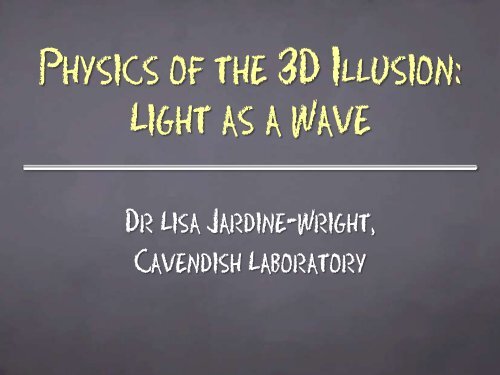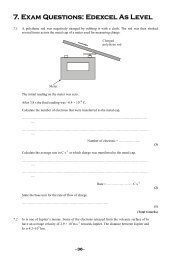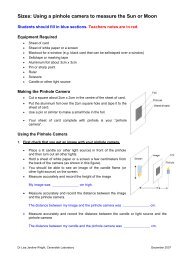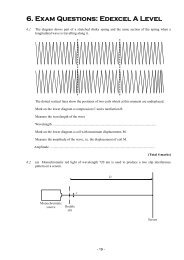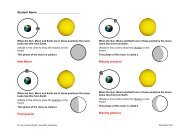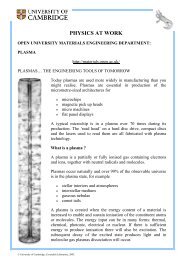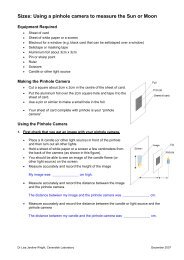Physics of the 3D Illusion: Light as a Wave
Physics of the 3D Illusion: Light as a Wave
Physics of the 3D Illusion: Light as a Wave
Create successful ePaper yourself
Turn your PDF publications into a flip-book with our unique Google optimized e-Paper software.
<strong>Physics</strong> <strong>of</strong> <strong>the</strong> <strong>3D</strong> <strong>Illusion</strong>:<br />
<strong>Light</strong> <strong>as</strong> a <strong>Wave</strong><br />
Dr Lisa Jardine-Wright,<br />
Cavendish Laboratory
What is a <strong>Wave</strong>?<br />
• A wave is a disturbance which travels<br />
from one place to ano<strong>the</strong>r.<br />
• As it travels, <strong>the</strong> wave transfers energy<br />
from one place to ano<strong>the</strong>r but NOT<br />
material.
Describing <strong>Wave</strong>s<br />
• <strong>Wave</strong>length, λ<br />
o Distance before <strong>the</strong> wave repeats.<br />
o Units are metres, m.<br />
λ<br />
o E.g distance between two peaks or troughs<br />
<strong>of</strong> <strong>the</strong> wave.<br />
λ<br />
λ
Describing <strong>Wave</strong>s<br />
• Frequency, f<br />
–The number <strong>of</strong> whole waves that p<strong>as</strong>s a<br />
fixed point each second.<br />
–Unit is Hertz, Hz.<br />
0.5 Hz
Describing <strong>Wave</strong>s<br />
• Amplitude, a<br />
–Maximum displacement <strong>of</strong> <strong>the</strong> wave.
Describing <strong>Wave</strong>s<br />
• Speed <strong>of</strong> <strong>the</strong> wave, v<br />
o Speed = frequency x wavelength<br />
v=f x λ<br />
• The speed <strong>of</strong> a wave is only altered by<br />
changing <strong>the</strong> medium through which it<br />
travels.<br />
o Speed <strong>of</strong> sound in air = 340 m/s<br />
o Speed <strong>of</strong> sound in water ≈ 1500 m/s
Types <strong>of</strong> <strong>Wave</strong><br />
• Transverse<br />
Direction <strong>of</strong> <strong>the</strong> energy<br />
transfer<br />
• Longitudinal<br />
Direction <strong>of</strong> <strong>the</strong> energy<br />
transfer
Types <strong>of</strong> wave
Examples <strong>of</strong> <strong>Wave</strong>s<br />
• Sound<br />
–Longitudinal<br />
–Mechanical
Examples <strong>of</strong> <strong>Wave</strong>s<br />
• Ripples on a pond<br />
–Transverse<br />
–Mechanical
Examples <strong>of</strong> <strong>Wave</strong>s<br />
• Mechanical waves need a medium to<br />
travel through.<br />
• <strong>Light</strong><br />
o Transverse<br />
o Electromagnetic<br />
o Can travel through a vacuum – How!
Electromagnetic Spectrum: <strong>Light</strong>
Electromagnetic waves<br />
• Visible light is a combination <strong>of</strong> electric<br />
and magnetic field at right angles to<br />
each o<strong>the</strong>r.<br />
o The direction <strong>of</strong> <strong>the</strong> electric field is usually<br />
used to describe <strong>the</strong> wave.
How or Why do we see in 3d?<br />
• Two very slightly different<br />
perspectives.<br />
o Each eye views <strong>the</strong> world from slightly<br />
different positions which gives <strong>the</strong><br />
illusion <strong>of</strong> depth.<br />
o What happens if we can only use one eye?
Convincing <strong>the</strong> Brain<br />
• A 2d image can appear 3d if we<br />
convince <strong>the</strong> brain that each eye is<br />
seeing something slightly different.<br />
• Stereograms...
Using colour filters<br />
• We can make <strong>the</strong> eyes see different<br />
things if each eye can only see one<br />
colour!
Colour filtering?<br />
What does this<br />
say when you look<br />
through <strong>the</strong> red<br />
filter and read?
<strong>3D</strong> & Colour<br />
• What<br />
direction is<br />
<strong>the</strong> dog’s<br />
nose pointing<br />
when you<br />
look through<br />
<strong>the</strong> red<br />
filter?
Using Polarisation<br />
• Instead <strong>of</strong> using colour filters we can<br />
polarise <strong>the</strong> light so that each eye sees<br />
a slightly different image.<br />
• What is polarisation?
Linear Polarisation<br />
Wire grid polariser<br />
Unpolarised light =<br />
many different electric field directions
Linear Polarisation<br />
• A Polaroid polarizing filter is ra<strong>the</strong>r<br />
similar to <strong>the</strong> wire-grid polarizer.
Linear Polarisation by Reflection<br />
• Non-metallic surfaces such <strong>as</strong> <strong>as</strong>phalt<br />
roadways, snowfields and water reflect<br />
light such<br />
that it is<br />
polarised<br />
parallel to<br />
<strong>the</strong> reflecting<br />
surface.
Polarisation in Use
Polarisation in Use
Linear Polarisation by Refraction<br />
• When light<br />
refracts it<br />
will also be<br />
polarised.<br />
• <strong>Light</strong> can be<br />
polarised by<br />
crystals
Circular Polarisation<br />
<strong>Light</strong> travels f<strong>as</strong>ter in this direction
Circular Polarisation
Circular polarisation example
Circular Polarisation & <strong>3D</strong><br />
Right Handed<br />
Left Handed
<strong>Light</strong> & L<strong>as</strong>ers<br />
• <strong>Light</strong> Amplification<br />
by stimulation <strong>of</strong><br />
emission radiation<br />
• L<strong>as</strong>ers are useful<br />
because <strong>the</strong>ir light<br />
is monochromatic &<br />
coherent
Coherent waves<br />
• Coherent waves are<br />
waves that are in<br />
ph<strong>as</strong>e with each o<strong>the</strong>r.<br />
• Ordinary light is not<br />
coherent because it<br />
comes from<br />
independent atoms<br />
which emit on time scales <strong>of</strong> about 10 -8<br />
seconds.
How do l<strong>as</strong>ers work?
How do l<strong>as</strong>ers work?<br />
hyperphysics.phy-<strong>as</strong>tr.gsu.edu
<strong>3D</strong> in Action: Where to go first!<br />
30 th March 31 st March<br />
A<br />
(lecture<br />
<strong>the</strong>atre)<br />
B<br />
(Labs)<br />
• Ely College<br />
• Stephen Perse<br />
• Impington<br />
• Stowmarket<br />
• Great Cornard<br />
• Hartismere<br />
• Wymondham<br />
• Abbey College
2 pm<br />
Programme<br />
Group A<br />
Experimenting<br />
with vision & <strong>3D</strong><br />
(Workshop)<br />
Group B<br />
Uses <strong>of</strong> <strong>Light</strong> in<br />
Bio<strong>Physics</strong><br />
(Talks)<br />
2:45 pm Break<br />
3 pm Break<br />
Experimenting<br />
3:15 pm Uses <strong>of</strong> <strong>Light</strong> in<br />
with vision & <strong>3D</strong><br />
Bio<strong>Physics</strong><br />
(Workshop)<br />
(Talks)<br />
4pm<br />
THE END


